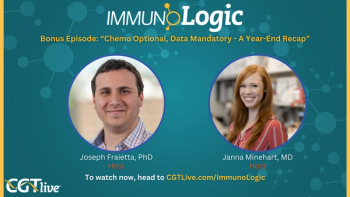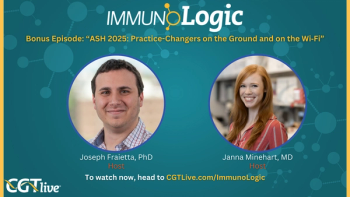
LV20.19 CAR T-Cells Show Efficacy in CLL, Richter, But Unusual Rates of IEC-HS
Going forward, the dose for patients with CLL has been reduced to 1x106 cells/kg.
LV20.19
These data, from a phase 1/2 clinical trial (NCT04186520), were presented by Nirav N. Shah, MD, associate professor, Medical College of Wisconsin, at
“Thinking about CLL, there are no approved products, although we anticipate some in the future, for either CLL or something specific to RT,” Shah said during his presentation. “Moreso, we think of CLL as being a CD20–dim histology, but recent studies have shown that drugs like obinutuzumab do have clinical benefit and do target the CD20 protein on B-cells.”
Shah and colleagues evaluated LV20.19, a bispecific anti-CD20/anti-CD19 CAR T-cell therapy, in 6 patients with RT and 11 with CLL with a median of 3 prior lines of therapy (range, 2-10). Most patients were male (n = 15; 88%) and median age was 65 years (range, 55-79).Patients with CLL had a median of 5 prior lines of therapy (range, 2-10) and patients with RT had a median of 3 prior lines of therapy (range, 2-5). Eight patients (47%) had Tp53 aberrations, and 9 patients (53%) had complex cytogenetics. Ten of 11 patients with CLL had disease double-refractory to BTK inhibitors and BCL2 inhibitors.
WATCH NOW:
The investigators found that 16 of 17 (94%) patients developed cytokine release syndrome (CRS), 2 of which, with CLL, had grade 3 CRS. Most cases required tocilizumab (93%). Three patients developed immune effector cell-associated neurotoxicity syndrome (ICANS; 18%): 2 patients with CLL developed grade 3 and 4 ICANS (the latter was found to have CLL involvement in the CS.
ICE-HS developing in 10 patients (59%) and 55% of patients with CLL; 2 patients with CLL had grade 3 and grade 4 IEC-HS which were classified as dose limiting toxicities (DLT). The median ferritin in patients with IEC-HS was 24,862 ng/mL compared with 447 ng/mL in patients without IEC-HS. Between patients with CLL who did and did not develop IEC-HS, there was no difference in CAR expansion or the CAR products themselves and disease biology seems to be the driving factor for developing IEC-HS
There were 2 non-relapsed mortality events, 1 from fungemia at 27 days and another from COVID19 infection at 14 months. Going forward, the dose was reduced to 1x106 cells/kg for patients with CLL.
For patients with CLL, overall response rate (ORR) at day 28 for evaluable patients with CLL (n=10) was 70%, with a 20% complete response (CR) rate, a 50% partial response (PR) rate, a 20% stable disease (SD) rate, and a 10% progressive disease rate.At this time point, bone marrow was negative for disease in 90%. Median follow-up time of 11 months and progression-free survival has not been reached. One patient had no CAR expansion and disease progression at day 28. The other patient died from fungemia.1
For patients with RT, ORR was 83% (50% CR, 33% PR, 16% SD). Bone marrow was negative for disease in all patients and median follow-up was 14 months. Two patients had relapsed disease, both of which had clonal evolution with CD19 and CD20-negative lymphoma.1
Shah noted that long-term response cannot be predicted with the short evaluation time and Hallek criteria used for patients with CLL.
“A lot to learned here in this population and it shows has the importance of testing differentCARs out in different histologies, but so far, we think there is some benefit of dual targeting CD20 in addition to CD19 and we hope to optimize the dosing to get a better safety/efficacy balance for patients with CLL and look to continue treating patients with RT,” Shah concluded.
REFERENCE
1. Shah NN, Atallah EL, Abedin S, et al. Phase 1 Trial of LV20.19 CAR T-Cells for Relapsed, Refractory CLL and Richter’s Transformation. Presented at: 2024 Tandem Meetings, February 21-24, San Antonio, Texas. Abstract #40
Newsletter
Stay at the forefront of cutting-edge science with CGT—your direct line to expert insights, breakthrough data, and real-time coverage of the latest advancements in cell and gene therapy.





































